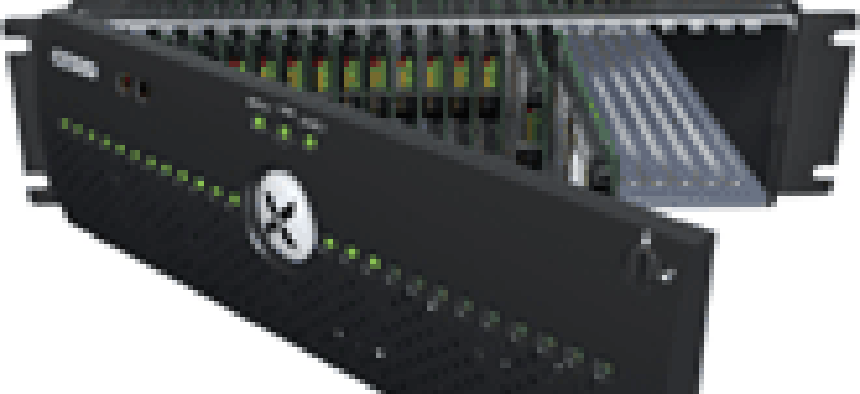Blade servers have come on like gangbusters in the last year, for two good reasons'they can save you space and money.According to a report from International Data Corp. of Framingham, Mass., blade servers make up fastest-growing server market segment, expanding 763 percent from year-to-year. It estimates that blades will account for more than one quarter of the total server market by 2007.Vendors are jumping on the bandwagon'in looking for blade suppliers, I found twice as many this year as last year. They include smaller companies, such as Egenera Inc. and RLX Technologies Inc., that have invested all their time and research into blades, and established server manufacturers like Dell Inc., Hewlett-Packard Co., IBM Corp. and Sun Microsystems Inc., that have expanded their offerings.For purposes of this guide, a blade server is a proprietary rackmount chassis in which many ultrathin computing blades share centralized resources such as management modules, Gigabit Ethernet network switches, hot-swap power supplies and fans.The letter U, with one U being 1.75 inches by 19 inches, designates the size of each chassis. Thus, a basic blade server chassis is typically 2U, 3U, 4U, 6U or 7U (12 inches) high.In traditional rackmount server arrangements, one U typically holds a single processor. But because the blades are laid side by side, like books on a shelf, instead of being stacked horizontally, a single 3U chassis can hold as many as 24 blades. By stacking 3U units in a typical 42U data center configuration, you can manage up to 280 blades.A good example of a typical third-generation blade server is Bull HN Information Systems' NovaScale Blade Chassis, recently introduced to the U.S. market. The redundant chassis holds up to 14 dual-processor server blades or seven multiple-processor blades'28 processors'in a 7U space. That's twice the density of rackmount servers.The system includes a built-in management module that monitors temperature and controls fan speeds to maintain the operating environment. The chassis holds up to two management modules for redundancy.On the back of the chassis are shared components: power supplies, blowers, switches and management modules, all of which are hot-plug/hot-swap components that can be removed without tools. A midplane provides network, power and KVM (keyboard, video, mouse) connections between individual blades and shared components.While the NovaScale is a good example of blade server chassis design, few chassis systems or the blades that go into them are exactly alike. Indeed, blades can vary dramatically in processing capability, speed and design.RLX Technologies has built an extensive array of blades, including the 1200i and 800i ServerBlades to fit the 300ex chassis listed in the accompanying chart. The 300ex can hold up to 12 1200i blades, which are powered by a 1.2-GHz Pentium III processor with up to 2G of memory. The company also has a 6U unit, the 600ex. The HP ProLiant BL e-Class of blade servers is designed for massively parallel computing environments and provides industry standard 32-bit computing in an ultradense, modular package. The IBM BladeCenter HS20 is powered by one or two Xeon processors running at up to 3.2 GHz, with a 533-MHz front-side bus, up to 8G of synchronous dynamic RAM and two Gigabit Ethernet controllers with load balancing and failover features. The BladeCenter HS40 is IBM's first foray into quad-processor capability for high-end data center consolidation requirements.The benefits of blade servers are clear, among them better server density, simplified deployment and management, and improved uptime.Taken together, these benefits are likely to save money compared with traditional pedestal or rackmount systems.Because the blades share the power supply, networking, cooling system and management resources provided by a single chassis, the cost of duplicating them as in traditional servers is greatly reduced. With blade systems, per-unit costs drop as blades are added.Blade servers also reduce deployment costs, both immediately through integrated components and over time with automated deployment software.Despite these benefits, there are a couple of caveats with blade servers: a lack of standards and a shortage of reliable management software.As for standards, vendors are getting better at managing different types of blades with different capacities and processors running in the same chassis. Sun Microsystems may be the leader in this regard, with the Sun Fire B1600 Blade Platform able to utilize blades holding Sparc and Intel Pentium III or Xeon processors on the same platform while running both Solaris and Linux applications.But there is still no standard for blade interconnects'that is, the blade ports within the chassis. Sun's blades won't run in IBM's chassis, IBM blades won't run in HP's shelves, and so on. Meanwhile, Intel Corp., backed by IBM and some other vendors, is promoting its Infiniband connection technology for blade interconnects, but the rest of the server world has yet to jump aboard.Blade management is a huge issue. Virtually all blade server chassis systems offer one or two redundant management modules, but you need to be certain of what functions the modules perform.Generally, users want to monitor blade availability and performance and quickly spot potential problems. And they want some level of policy-based management in which predefined actions for configuration, security, provisioning and performance may be set and sent around the network.Most servers provide various levels of software to manage their blades. IBM Director Management software, for instance, provides most of the functions listed above and is provided free with its eServer blades.Hewlett-Packard's Insight Manager 7, along with Integrated Administrator, HP Toptools and HP Server Manager, helps manage its blade servers as competently as its pedestal and rackmount server series, as does Fujitsu's package of Primergy Server Management tools. Some third-party manufacturers are also making blade management software.
RLX Technologies' System 300ex Chassis, priced at $3,160 GSA, holds up to 12 of the company's 1200i blades and up to 24 of its 800i blades; like other chassis, it lets blades share components such as power supplies, management modules and cooling fans.
Interconnect issuesJ.B. Miles of Honomu, Hawaii, writes about communications and computers. E-mail him at jbmiles@starband.net. 






